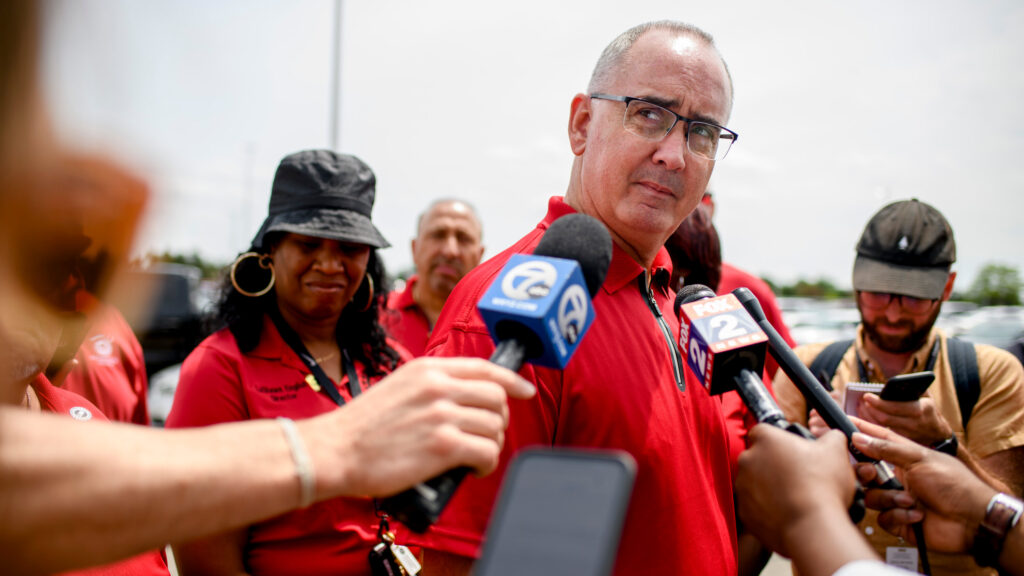UAW Wins on the EV Question

Blogging has been light because I have had people in town for most of the last three weeks. Meanwhile, there’s a lot of news on the labor front that has developed. Probably the most important thing is the UAW winning big on the future of electric vehicles, at least with GM. This has huge implications for a just transition.
The news last Friday that General Motors has agreed to the UAW’s demand that workers at GM’s joint-venture EV battery factories will be covered under the automaker’s master contract with the union is a historic breakthrough for American workers as they face transitions to a post–fossil fuel economy.
Until Friday, the U.S. auto companies were almost uniformly resisting the idea that their employees in the EV industry would receive wages and benefits comparable to those that UAW members had long received. Now, GM (and almost surely Ford and Stellantis, following in its wake) will effectively ratify the UAW’s argument that work in the new EV economy can provide the living standards that once enabled UAW members to thrive.
The UAW can now take that selling point to the workers at Tesla, and at the non-union EV factories springing up in the South. And President Biden can cite this breakthrough as a concrete refutation of Donald Trump’s harangues that the shift to EVs foretells the doom of American workers.
In announcing this epochal development, UAW President Shawn Fain said that GM changed its position on the eve of the union’s threatened expansion of its strike to the company’s huge plant in Arlington, Texas, which, Fain said, is GM’s single biggest revenue producer. The escalation to a key GM facility echoes the tipping point in the UAW’s sit-down strike in Flint, Michigan, in 1937, which led to the unionization of most American manufacturing.
Workers had already barricaded themselves into two of the many GM factories in Flint, but more than a month in, the company still refused to bargain. In a desperate effort to break the deadlock, the union spread the word to its activists, which also meant to the many GM spies within the activists’ ranks, that it would seize another factory, Chevrolet #9, the following day. When they launched that effort, GM turned out its goons in force to repel it, and the battle lasted for hours. Only belatedly did the company notice that the UAW had quietly barricaded itself in Chevrolet #4 while all the fighting at #9 was going on. Chevrolet #4 had been the UAW’s real target all along, as it made the parts that every other GM plant in the country needed. With Chevy #4 occupied, GM had no recourse but to recognize the union.
Fain often cites the UAW’s militant and very successful history of building worker power, and by making clear the strike was about to expand to Arlington, he hit GM in its pocketbook, much as Walter Reuther, Wyndham Mortimer, and other UAW founders did when they decided to shut down Chevy #4.
But there’s another historic antecedent for what the UAW won, and that concerns the issue of transitioning to a new and more efficient form of production. The conventional wisdom is that building an electric vehicle requires fewer workers than building a gas-powered vehicle, because EVs have fewer parts. But Heatmap News last week suggested that the evidence for this was thin, and that if you take into account the production of component parts like batteries, the workforce needed is roughly the same or could even be higher.
Ford is balking at joining GM, but it’s hard to see how it holds out here. When you have a giant industry like this, the contracts end up being pretty similar. There’s certainly no logical reason why Ford can’t do this if GM can, except that they don’t want to.
The simple fact is that you are not going to have a transition to a green economy without unions on board. They might only be 10% of the workforce, but they are a far higher percentage of people who actually build things, especially the kind of large projects necessary to move the nation to a greener economy. This is how you get unions on board–you make it a real just transition that ensures new forms of work exist under union contracts. Any employer who opposes this does not actually support a green economy.


